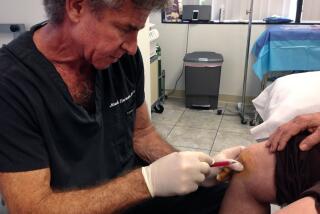Stem cell agency board criticized for conflicts of interest
- Share via
The board of California’s stem cell funding agency is rife with conflicts of interest and should be restructured to improve the integrity of its grant-making process, according to a new report from independent experts convened by the national Institute of Medicine.
The committee found that “far too many” of the board members are from organizations that stand to benefit from the $3 billion the California Institute for Regenerative Medicine is supposed to dole out to researchers over 10 years. Making matters worse, the panel said, the 29 board members are too closely involved in the agency’s day-to-day decisions.
“They make proposals to themselves, essentially, regarding what should be funded,” said Harold Shapiro, former president of Princeton University and chair of the 13-person committee that issued the report Thursday. “They cannot exert independent oversight.”
The findings echo criticisms that have been made for years by independent groups that monitor how taxpayer dollars are spent.
“Conflict of interest is a fundamental problem with the agency,” said John Simpson, head of the stem cell project at Consumer Watchdog in Santa Monica.
The agency, known as CIRM, was established after voters approved Proposition 71 in 2004, authorizing the state to issue $3 billion in bonds to support stem cell research in California (along with $3 billion in interest payments).
Thus far, CIRM has allocated nearly $1.7 billion to 68 institutions, including Stanford University, UCLA and biotechnology firms such as StemCells Inc. and Geron Corp. That money has contributed to advances in basic research in stem cell biology, helped speed cures to patients and built state-of-the-art research facilities throughout California.
But from the get-go the agency and its primary backer, San Francisco real estate investor Robert Klein, came under intense scrutiny for problems with transparency and other governance issues.
Proposition 71 required that CIRM’s board, the Independent Citizens’ Oversight Committee, be composed primarily of representatives from research centers, biotech companies and advocacy groups for patients whose diseases might be treated by stem cell therapies. The arrangement set it up for conflicts of interest: An investigation by California’s Little Hoover Commission in 2008 determined that the board lacked independent voices. About 90% of CIRM grants have gone to institutions with representatives on its board.
In the new report, the Institute of Medicine panel urged the agency to create a permanent scientific advisory board to make recommendations to the CIRM staff about scientific priorities, including what types of research to pursue and how to collaborate with industry. That board should be composed mainly of experts from outside California who are not eligible for CIRM funding, the panel said.
The report did not call out specific cases in which conflicts of interest were problematic, focusing instead on structural issues, Shapiro said.
In addition, the agency should lay out plans for how it will line up new funding after 2017, when it will run out of money for new grants, the panel said.
Shapiro praised CIRM’s leadership for “extraordinary work” in its first five years and for getting the agency off the ground. “The focus of our report is looking forward,” he said.
Critics of the agency welcomed the findings. But they also noted that the recommended changes wouldn’t be easy to implement. A number of board members would be likely to resist their removal from the grant-approval process, and some of the needed structural changes would require action from the California Legislature, said David Jensen, editor of the California Stem Cell Report, who follows the agency closely.
Jonathan Thomas, who succeeded Klein as CIRM board chairman in 2011, said he was encouraged by the report’s emphasis on future funding concerns, which wouldn’t be an issue if the panel didn’t think CIRM’s work was very important.
He said board members had not yet studied the recommendations in detail, and but that they “will spend a great deal of time” doing so in the coming weeks.
Their work could begin in earnest Wednesday, when Shapiro will present the report at CIRM’s December board meeting in Los Angeles.
Simpson of Consumer Watchdog said CIRM would have to address the governance issues if it intended to ask taxpayers for more funding. “If they continue to have blatant conflicts of interest, that’s going to be challenging,” he said.
CIRM commissioned the Institute of Medicine report in 2011. The $700,000 audit, which was paid for by donations to the stem cell agency, took about two years to complete, Shapiro said.
More to Read
Sign up for Essential California
The most important California stories and recommendations in your inbox every morning.
You may occasionally receive promotional content from the Los Angeles Times.











